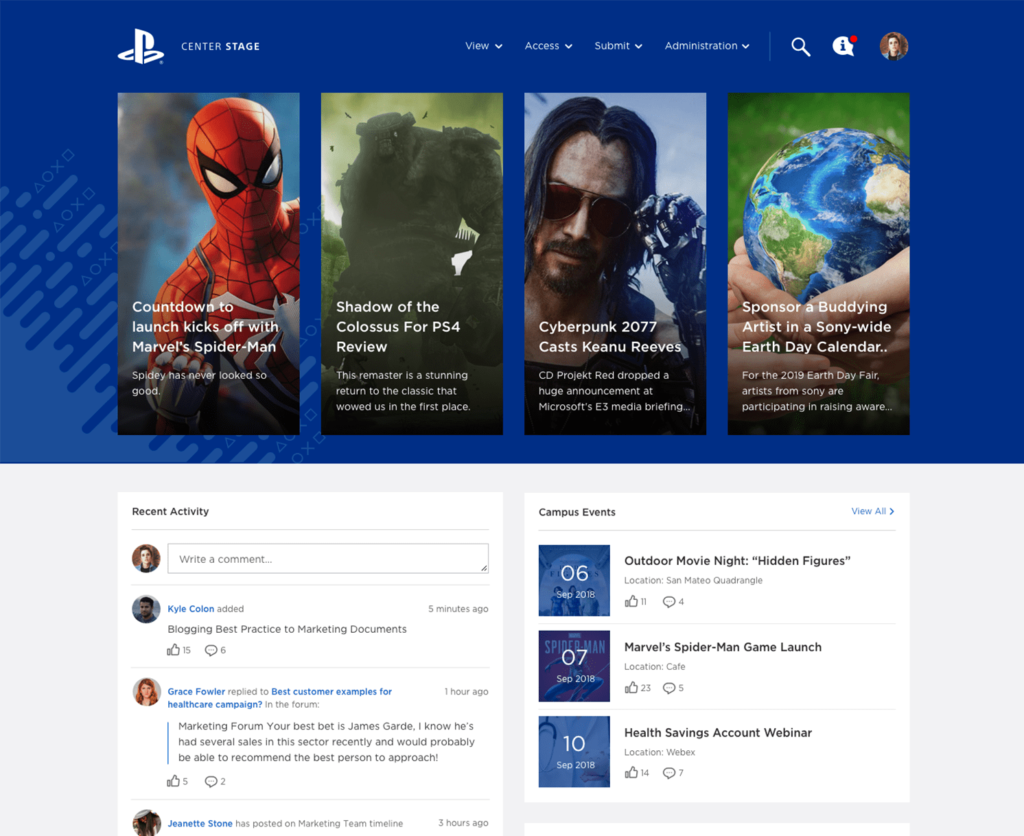Intranet solutions 101: how to choose the right intranet for you

No two intranets are the same. When it comes to software, there are so many choices, functionalities, and capabilities out there. So, how do you know which intranet solutions are the best for you and your organization?
Choosing your business’s intranet is a big responsibility. Aside from the investment of time involved in establishing the system, you have the expectations of your workforce, the trust of your stakeholders, and the relatively large financial cost weighing on your final decision. It’s a heavy burden to bear.
But like all things that affect the workforce, it’s crucial to involve all the relevant people who can bring their own experiences to the table and help you choose which software is the best addition to your organization.
With this in mind, we’ve drawn together a list of things to consider if you’re at the start of your intranet journey.
What to bear in mind when looking at intranet solutions

We’re aware that buying an intranet is critical on a number of levels, which means that the decision making needs to be thorough, involve as many opinions in the workforce as possible, and isn’t rushed through. After all, getting rid of implemented software is more problematic – and expensive – than taking the time to pick the right brand for your organization.
Through our work with companies across the globe, we know the many challenges that face organizations in their search to find software that fits their unique way of working. In our experience, pressures from other areas of the business often derail the intranet planning journey. The most common of these include:
“Go for Product X. We used it in my last place” One of the biggest mistakes you can make is heeding the advice of a colleague who has used a particular brand in a place where they used to work. While they sing its praises, you need to remember two things. The first is that your organization is more than likely a lot different than their former place of work, with different goals, aims, and ways of working. The second thing is that social platforms move fast. The intranet of a few years ago may be deemed obsolete compared to the features and functions of a present-day intranet. With that in mind, it’s essential to stay current and see how agile the software you are interested in is.
“This is IT’s responsibility” Another thing to bear in mind is the importance of not letting one department hold sway over the decision-making. For example, what the IT department wants is very different to the other wants and needs of other areas of the business. For example, a service that might be easy for IT to manage, like a SharePoint intranet, may not be so easy for the end-user. Similarly, an intranet weighted in HR’s favor might be missing out on other vital elements. To get an even representation, make sure you define high-level business requirements, explore data and output from your focus groups across the whole of your organization.
“We need this wrapping up in the next six weeks” We speak to so many businesses about their intranet journey. It’s something that fascinates us, simply because each story is so different. However, what we’ve noticed is that an overwhelming majority of these companies say that they underestimated the amount of time it took to prepare, choose, and deploy their chosen intranet. So, why does it take so long?
It’s important to remember how integral this piece of software is, and how it could help define your business in the years to come. It shapes employee engagement, job satisfaction, communication, and collaboration. Having such a weighty role in the organization, it’s no wonder that these projects can overrun. The average period between inquiry to final sign off is six to nine months (and for bigger, enterprise companies, that can stretch as far as two years). So, it’s clear that when it comes to choosing the right intranet deal, it’s a decision that shouldn’t be rushed or taken lightly. We advise all organizations before they set a time limit, to have a defined plan about exactly what needs to be doing. The many obligations can often exceed initial expectations.
The 7 questions to getting the right intranet solutions

It might seem like a huge task to choose one package out of the many intranet providers on offer, but the real work should actually begin a long time before. You need to approach the marketplace with a real idea of what you want and what you need. This is essential so you can rule out a lot of software on offer and come to the final selection a lot more quickly.
#1: Does it align with your business’s core values?
Your business’s core values will have been carefully crafted and should encompass the essence of what you strive to be as a company. It should take into account how it plans to achieve its mission and create a welcome and engaging workplace for people within it to succeed. As a result, these values become a behavioral touchstone for the company, a set of cultural guidelines.
“It makes sense, when you invest in software that will be used by every member of your organization that you align your values with it.”
So, it makes sense, when you invest in software that will be used by every member of your organization, every day, in which to communicate, connect and collaborate, that you align your values with it. The many different functions of a modern intranet can help you do this, from rewards and recognition to instant messaging, to rapid information finding to the ease of forming collaborative groups.
#2: Does your intranet enable integrations?
Think about what you want your intranet to do. Could you automate a lot of your processes? Make your administrative tasks more paperless? Speed up many of your organization’s time-consuming chores? Many organizations run their payroll, HR admin, and other processes through their intranet, often using the same third-party software as used previously.
For example, Marketing can benefit from O365 and G-Suite integration. Sales can use an integrated Salesforce app or similar. Support can access ZenDesk through their intranet. All this means that your intranet becomes the center of your employees’ digital workplace and, as a result, an essential tool in your business.

#3: What is the intranet’s user experience (UX) like?
The user experience is like accidental music in a film. If you notice it, it’s not doing its job. Good UX should feel effortless, intuitive, and automatic. When you’re aware of the interface on a site, it’s a sign that it’s not working as it should. This can lead to frustrations, workarounds and perhaps, a slow decrease in engagement: not what is desired with software that aims to do the opposite. Simply put, if it’s not useable, it’s not going to be used.
Choosing an intranet with excellent UX requires calling on people all over your company to be able to try before you buy. Different departments will use different areas of the intranet more than others, so make sure every corner of the system is explored.
“If your intranet’s not useable, it’s not going to be used.”
Another thing to bear in mind is mobile responsiveness. The UX on the mobile site should ideally be as good as, if not exceed, the desktop user experience. Allowing workers to use a mobile intranet is key to employee engagement with the new system. So, when you’re looking at features, it’s crucial that your provider offers an app option. While you may not think you require it now, having the opportunity to use an app across your workforce might be something your organization will need in the not so distant future. And with 70% of employees non-desk-based, an intranet app is fast becoming standard across companies.
#4: Are you happy with your intranet design?
They say that first impressions count, and intranet design is integral to whether your new system gets picked up quickly or not. Bad design can be a massive turn-off resulting in widespread disengagement.
Design acts as the shop window of your intranet: it brings people in. If your people do not instantly want to start using the new intranet, it doesn’t bode well for future intranet engagement levels.
“Design acts as the shop window of your intranet: it brings people in.”
Anyone planning on introducing an intranet solution into the business needs to have some kind of idea of what they want their platform to look like. This is the ideal opportunity to promote your internal branding and give your intranet an identity. Reinforcing your internal culture this way can be a boon when it comes to recruiting and employee engagement.

One of the benefits of a good intranet provider is that there is no such thing as final design. With their support, your team can evolve the look of your site as your business changes and evolves.
#5 What’s the tech support like?
When you’re implementing software across your workforce, it’s critical to make sure you have a strong tech support team to rely on. This doesn’t just mean initial bedding in support, but long-term assistance that responds quickly and resolves efficiently. But without buying the product first, how can you find out about customer support service levels? Find out what the provider offers.
Depending on your type of business, what kind of tech support do you require? Is it out of hours support? Do you need emergency contact 24 hours a day, seven days a week, 365 days a year? Fact-find, speak to current customers if possible, read reviews – and make sure you have a good idea of what kind of service you and your business require if you do experience any bugs or problems with your intranet down the line.
#6: Is the software futureproof?
How agile is the software you’re looking at? How can it evolve as your business develops? How adaptable is it to sudden change, business acquisition, changing applications? These are the questions you need to be asking before deploying software that will be used by every member of your workforce. Most businesses have ambitions to grow. Intranet software must move with a business that is going from strength to strength.
“How adaptable is your intranet to sudden change, business acquisition, changing applications?”
For this, you need to have a forecast of where your business is heading. How many people do you see being employed by your organization in two, three, five years? Do you plan to open new offices? Any plans to go global? Make sure your new system can work with different languages, different time zones, new departments being opened up. Ensuring your intranet is business-agile is integral to its long-term success and engagement within your company.
#7: Is it within the budget?
For all organizations, big and small, the budget can often be the deciding factor in which software you go for. Ultimately it all boils down to the number one question: how much are you willing to spend? Like most things, the most expensive package isn’t necessarily the best one for your situation. Conversely, the cheapest deal will bring a whole lot of drawbacks.
When it comes to budget, it’s so important to have a clear idea of what you need as a business now and in the foreseeable future. If the final price is over what you expected, look at what you could be saving in the long-term. An intranet used by the whole organization can aid employee retention, improve the employee lifecycle, and transform how people connect and share knowledge. The deal in question could offer round-the-clock support, training, and extra resources. Often these additional services and advantages can help shave off money in all areas of the business, and analysis should be made to support this.
Company intranet solutions

As we’ve illustrated, there is a lot to bear in mind when you are planning to deploy an intranet. And it’s a decision that can’t be made on its own. To make the right choice, you need the input of key figures within your organization, you need to listen to your workforce, and you need to have a vision of where your organization will be in five years.
With this, you need to be aware of your business’s shortcomings. What do you need to improve the time, money and people power currently spent on processes? How can the right software transform the various areas of your business? Knowing where you’ve been, where you are, and where you see yourselves in the future goes someway in discovering the right intranet software for your company.
